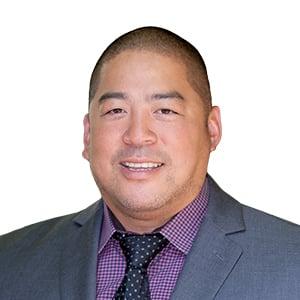If Jeff Blake has a personal motto, it probably boils down to two simple words: Move forward.
The 67-year-old IT specialist from La Crescenta, California, always kept a careful watch over his health. For decades, he got regular physical exams and PSA screenings (a blood test measuring the presence of prostate specific antigen) to check for prostate cancer: every two years in his forties, annually in his fifties and sixties.
So in February 2020, when his PSA reached 5.3, Blake was concerned. (A value of 1.0 to 1.5 is considered ideal. Anything above 4.0 is a red flag.)
He submitted to a biopsy a month later, and the news was not good. Blake had Stage 3 prostate cancer. Though he had several relatives who’d been treated for cancer over the years, he nevertheless recalls being “shocked” by the diagnosis.
But diligence had paid off. Thanks to his regular screenings, doctors had detected Blake’s cancer early enough to treat it surgically. It had not yet spread to nearby lymph nodes.
Unfortunately, for far too many people, diligence is taking a major hit during the COVID-19 pandemic. Patients are skipping their regular prostate checkups out of fear that they may catch the coronavirus in a hospital setting or crowded doctor’s office.
Bad idea, says Blake’s surgeon.
Nor should patients worry that they’ll be turned away because, as was the case at many hospitals, the staff is overwhelmed by COVID-19, leaving no room for elective procedures or “non-life-threatening” cases. This scenario simply did not take place at City of Hope, a private facility that does not receive general emergency calls through the 911 network. The number of COVID-19 cases among patients and staff on campus has been minimal, and separate, isolated facilities — with their own staffs — were set aside early on to handle them.
It can certainly feel daunting to deal with any kind of health issue in the face of a global pandemic. But it comes down to one’s priorities. Blake’s cancer diagnosis came exactly one day before the California statewide lockdown began. His surgery took place in May 2020, during the worst of the pandemic. And his entire recovery, which included multiple follow-up visits (some in person, others via telehealth, another new precaution) proceeded parallel to COVID-19’s rampage around the globe.
None of it fazed him. He had high praise for City of Hope and especially Lau.
“He answered all my questions, had a great bedside manner, and was so personable and straightforward,” he recalled. “And I had no hesitation going to City of Hope. I really appreciated all the precautions they took.”
Nor should anyone else hesitate, he said.
“No matter what you feel about COVID-19, life goes on. None of your conditions [like prostate cancer] ever take a break. But the opportunity [to catch it early] is right there. Take advantage of it! You can’t let some microvirus stop everything.
“You must move forward, get through it and come out on the other side. Don’t let COVID-19 stop you from living!”
The 67-year-old IT specialist from La Crescenta, California, always kept a careful watch over his health. For decades, he got regular physical exams and PSA screenings (a blood test measuring the presence of prostate specific antigen) to check for prostate cancer: every two years in his forties, annually in his fifties and sixties.
So in February 2020, when his PSA reached 5.3, Blake was concerned. (A value of 1.0 to 1.5 is considered ideal. Anything above 4.0 is a red flag.)
He submitted to a biopsy a month later, and the news was not good. Blake had Stage 3 prostate cancer. Though he had several relatives who’d been treated for cancer over the years, he nevertheless recalls being “shocked” by the diagnosis.
But diligence had paid off. Thanks to his regular screenings, doctors had detected Blake’s cancer early enough to treat it surgically. It had not yet spread to nearby lymph nodes.
Unfortunately, for far too many people, diligence is taking a major hit during the COVID-19 pandemic. Patients are skipping their regular prostate checkups out of fear that they may catch the coronavirus in a hospital setting or crowded doctor’s office.
Bad idea, says Blake’s surgeon.
“You must continue your screenings,” said Clayton S. Lau, M.D., chief of the Division of Urology and Urologic Oncology and director of the Prostate Cancer Program at City of Hope. “It’s how we decrease mortality, and by finding tumors earlier we can also use less aggressive therapy.”
Sound advice. But is it falling on deaf (or at least, frightened) ears? To a degree, yes.
“I’ve seen a 50-70% decline in screening rates,” Lau lamented, “especially in the first six months of the pandemic. People stopped coming in, and as a result, we were making far fewer diagnoses.” He says the numbers began to pick up when it appeared that vaccinations had helped us turn the corner on COVID-19. However, with the Delta variant now raging, Lau worries that screenings may drop again.
Especially since so many of us are so good at rationalizing and staying home.
For example, there may be a tendency among some men to dismiss the importance of regular screenings because they’ve heard that most prostate cancers grow very slowly and are far less likely to be lethal like, say, lung cancer. They’ve seen the statistics that point to a better than 90% survival rate for most prostate cancers. So what’s the rush, they reason? Why not skip a PSA check? Or two? Especially when there’s a much more immediate danger — like a pandemic — to consider.
Lau, the Pauline & Martin Collins Family Chair in Urology, is eager to dispel such notions, explaining that a significant portion of prostate cancers — as high as 40% in some populations — are aggressive and potentially deadly. In fact, prostate cancer is the second leading cause of cancer death among men in the U.S., with 94 patients dying from it every day.
Regular screenings are a powerful defense against those deadliest cases. That’s because a single high PSA number by itself isn’t nearly as important as tracking the rate of increase over time. If the PSA number has risen sharply recently, that’s a danger signal. (The second indicator of aggressive disease is the so-called Gleason score, named for the pathologist who developed it. A Gleason score is based on the microscopic appearance of cancer cells taken from a biopsy. Higher scores indicate more aggressive cancer with a worse prognosis.)
It’s especially important, Lau says, to track your PSA number carefully if there’s prostate cancer in your family. The American Cancer Society recommends such high-risk people begin screenings as early as age 40. Most others can wait until age 50. After age 75, screenings are no longer recommended.
Still, the fear of catching COVID-19 is strong, so Lau works every day to reassure his patients, outlining the multiple layers of protections and precautions — from vaccines to masks to temperature checks to a strict visitors policy and much more — employed at City of Hope. “Don’t be afraid,” he urges. “City of Hope does a fantastic job at keeping people safe.”
Sound advice. But is it falling on deaf (or at least, frightened) ears? To a degree, yes.
“I’ve seen a 50-70% decline in screening rates,” Lau lamented, “especially in the first six months of the pandemic. People stopped coming in, and as a result, we were making far fewer diagnoses.” He says the numbers began to pick up when it appeared that vaccinations had helped us turn the corner on COVID-19. However, with the Delta variant now raging, Lau worries that screenings may drop again.
Especially since so many of us are so good at rationalizing and staying home.
For example, there may be a tendency among some men to dismiss the importance of regular screenings because they’ve heard that most prostate cancers grow very slowly and are far less likely to be lethal like, say, lung cancer. They’ve seen the statistics that point to a better than 90% survival rate for most prostate cancers. So what’s the rush, they reason? Why not skip a PSA check? Or two? Especially when there’s a much more immediate danger — like a pandemic — to consider.
Lau, the Pauline & Martin Collins Family Chair in Urology, is eager to dispel such notions, explaining that a significant portion of prostate cancers — as high as 40% in some populations — are aggressive and potentially deadly. In fact, prostate cancer is the second leading cause of cancer death among men in the U.S., with 94 patients dying from it every day.
Regular screenings are a powerful defense against those deadliest cases. That’s because a single high PSA number by itself isn’t nearly as important as tracking the rate of increase over time. If the PSA number has risen sharply recently, that’s a danger signal. (The second indicator of aggressive disease is the so-called Gleason score, named for the pathologist who developed it. A Gleason score is based on the microscopic appearance of cancer cells taken from a biopsy. Higher scores indicate more aggressive cancer with a worse prognosis.)
It’s especially important, Lau says, to track your PSA number carefully if there’s prostate cancer in your family. The American Cancer Society recommends such high-risk people begin screenings as early as age 40. Most others can wait until age 50. After age 75, screenings are no longer recommended.
Still, the fear of catching COVID-19 is strong, so Lau works every day to reassure his patients, outlining the multiple layers of protections and precautions — from vaccines to masks to temperature checks to a strict visitors policy and much more — employed at City of Hope. “Don’t be afraid,” he urges. “City of Hope does a fantastic job at keeping people safe.”
Nor should patients worry that they’ll be turned away because, as was the case at many hospitals, the staff is overwhelmed by COVID-19, leaving no room for elective procedures or “non-life-threatening” cases. This scenario simply did not take place at City of Hope, a private facility that does not receive general emergency calls through the 911 network. The number of COVID-19 cases among patients and staff on campus has been minimal, and separate, isolated facilities — with their own staffs — were set aside early on to handle them.
It can certainly feel daunting to deal with any kind of health issue in the face of a global pandemic. But it comes down to one’s priorities. Blake’s cancer diagnosis came exactly one day before the California statewide lockdown began. His surgery took place in May 2020, during the worst of the pandemic. And his entire recovery, which included multiple follow-up visits (some in person, others via telehealth, another new precaution) proceeded parallel to COVID-19’s rampage around the globe.
None of it fazed him. He had high praise for City of Hope and especially Lau.
“He answered all my questions, had a great bedside manner, and was so personable and straightforward,” he recalled. “And I had no hesitation going to City of Hope. I really appreciated all the precautions they took.”
Nor should anyone else hesitate, he said.
“No matter what you feel about COVID-19, life goes on. None of your conditions [like prostate cancer] ever take a break. But the opportunity [to catch it early] is right there. Take advantage of it! You can’t let some microvirus stop everything.
“You must move forward, get through it and come out on the other side. Don’t let COVID-19 stop you from living!”

